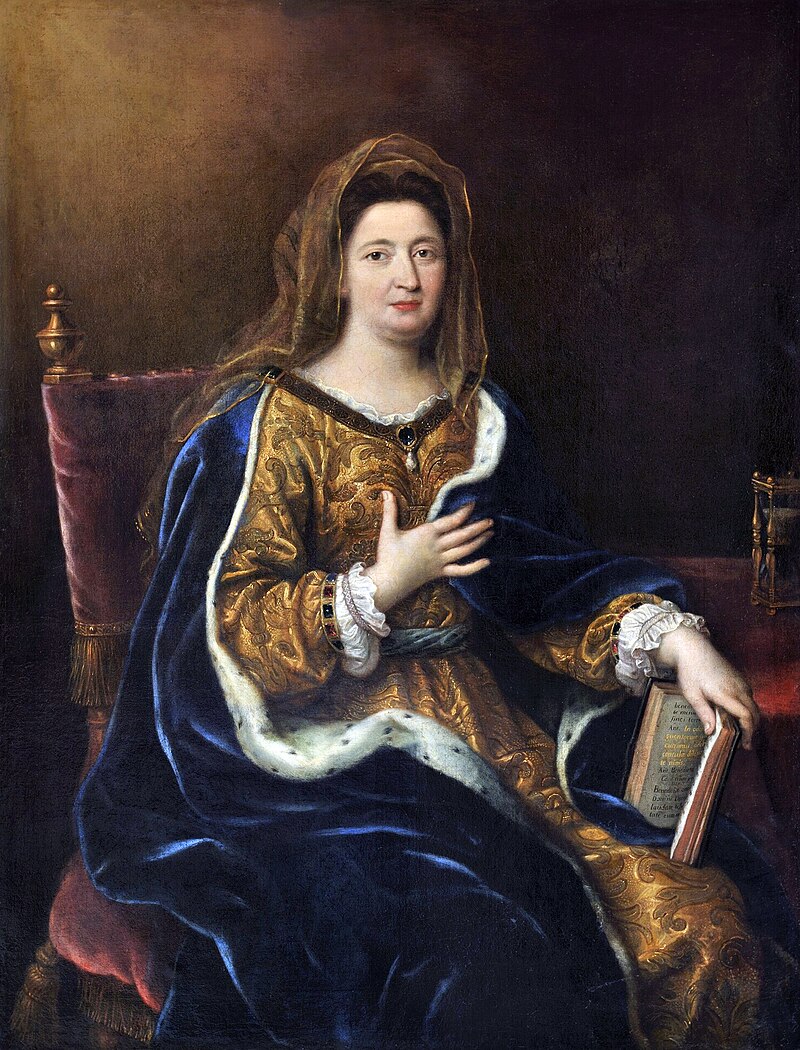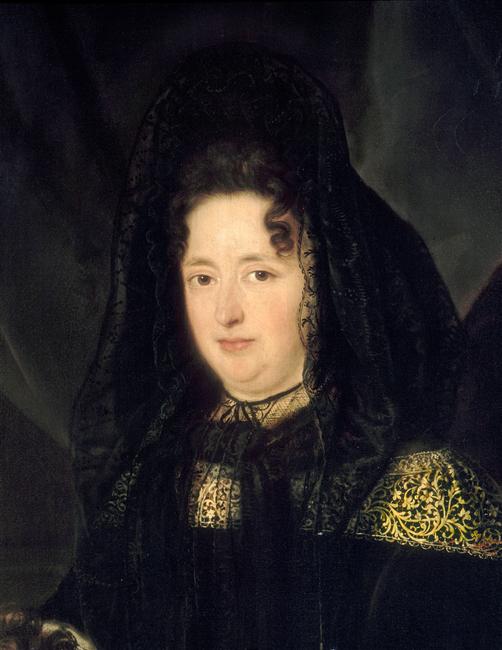by Scott Mehl © Unofficial Royalty 2016

Françoise d’Aubigné, Marquise de Maintenon, source: Wikipedia
Françoise d’Aubigné, Marquise de Maintenon, was the second and morganatic wife of King Louis XIV of France. She was born in Niort, France, on November 27, 1635, to Constant d’Aubigné and Jeanne de Cardilhac. At the time she was born, her father was imprisoned for conspiring against Cardinal Richelieu. Françoise was baptized in the Catholic Church, with Suzanne de Baudéan (daughter of the Comtesse de Neuillant) and the Duc de la Rochefoucauld serving as her godparents.
When her father was released from prison in 1639, the family traveled to Martinique where they spent the next several years. After the deaths of both of her parents, Françoise was raised by her father’s sister Louise, Madame de Villette, who continued her Protestant education. When her godmother Suzanne de Baudéan, then in the service of Queen Anne, the wife of King Louis XIII of France, found out about this, she quickly ordered that Françoise be moved to a convent to receive a Catholic education. Although she hated the convent, Françoise became close to one of the nuns, who persuaded her to take her first communion.

Paul Scarron, Françoise’s first husband. source: Wikipedia
On a trip to Paris, she met Paul Scarron, who would become her first husband. Scarron, a noted poet and novelist, was significantly older than Françoise and suffered from severe paralysis and deformity, probably a result of polio. The two began to correspond and soon Scarron offered to marry her or to pay her dowry to enter a convent. Françoise accepted his proposal and after marrying in 1652, she quickly found herself at the highest levels of Parisian society.
After her husband died in 1660, Françoise continued to receive the pension he had been granted from Queen Anne. The Queen increased the pension so that Françoise could maintain her position in society. However, after Queen Anne died in 1666, her son, King Louis XIV discontinued the pension. With no source of income, Françoise prepared to leave France to serve as a lady-in-waiting for the new Queen of Portugal, Maria Francisca of Savoy, who was married to King Afonso VI of Portugal, and later to his brother, King Pedro II of Portugal. However, before leaving, she met Madame de Montespan, the clandestine lover of King Louis XIV. The two became close friends, and Madame de Montespan persuaded the King to reinstate Françoise’s pension, thus allowing her to remain in Paris.
In March 1669, Madame Montespan had her first child with King Louis XIV. Because of the secrecy of their relationship, and the fact that he was very much married to Queen Marie-Thérèse, Montespan placed the baby in the care of Françoise and endowed her with a substantial income and a full staff of servants. It was Françoise’s care of the couple’s second child that got her noticed by King Louis XIV. In 1673, she was appointed as Royal Governess. In 1674, King Louis XIV provided her with the funds to purchase an estate, Château de Maintenon, and the following year he created her Marquise de Maintenon. Within a few years, Françoise and King Louis XIV had become very close, and she soon replaced Madame de Montespan in his affections. Even the Queen was pleased, having been treated quite rudely by Montespan, but receiving great respect and admiration from Françoise.

King Louis XIV, painted by Pierre Mignard. source: Wikipedia
Several months after Queen Marie-Thérèse died, Françoise and King Louis XIV were married in a private ceremony conducted by the Archbishop of Paris. As the marriage was morganatic, she was never formally acknowledged as his wife or as Queen of France. Still known as Madame de Maintenon, Françoise held considerable political influence, and the King often consulted with her when making decisions. She also held great influence over the King in more personal matters. Despite his earlier penchant for numerous mistresses, he remained faithful to Françoise for the remainder of his life and supported many of her religious views. Devoutly religious, she was granted the right of visitation over all the convents in France in 1692 by Pope Innocent XII.
In 1684, she founded the Maison royale de Saint-Louis in Saint-Cyr, just west of Versailles, France. At her request, King Louis XIV endowed the school, and Françoise herself oversaw every detail of its establishment. The Maison Royale was designed to be a school for girls from poorer noble families, much as Françoise had been in her childhood.

Françoise, painted by Louis Elle (the elder). source: Wikipedia
Following King Louis’s death in 1715, Françoise retired to Saint-Cyr and was granted a large pension for the rest of her life. Such was her influence within the monarchy that she often received visitors from all around Europe. One of these visitors was Peter I, Emperor of All Russia, who made a notable visit shortly before her death. Françoise died at Saint-Cyr on April 15, 1719, and was buried in the school’s chapel.
This article is the intellectual property of Unofficial Royalty and is NOT TO BE COPIED, EDITED, OR POSTED IN ANY FORM ON ANOTHER WEBSITE under any circumstances. It is permissible to use a link that directs to Unofficial Royalty.
